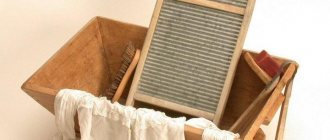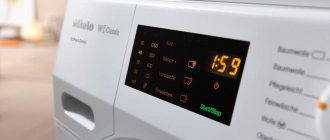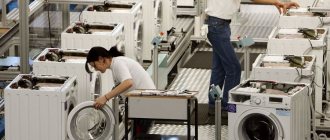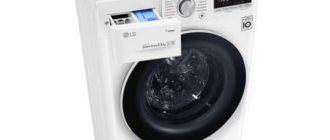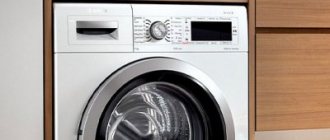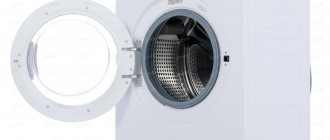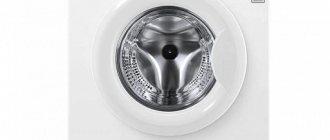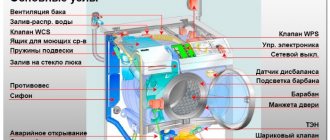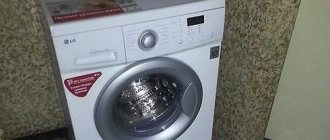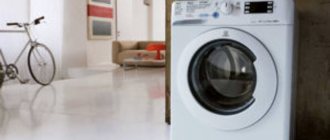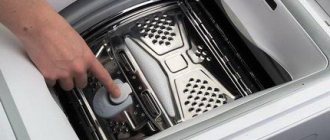The first washing machine in human history was invented by Noah Cushing. It was a hand-cranked device powered by rotating a handle. An analogue of such a machine was made in 1851 by the American James King. Serial production of washing machines began a little later, already in 1874. William Blackstone sold his homemade jigs for two and a half dollars apiece. By the way, the first copy of such a unit was given to my wife. A real breakthrough was the appearance of an internal combustion engine in the design of a washing machine, which was later replaced by an electric motor. Such units first appeared in Europe in the early 1900s; they were produced in Germany. Alva Fischer is considered the creator of the new generation of washing machines.
Our ancestors washed primarily in troughs or basins. To wash large volumes, housewives went to the river. The only assistant for women of that time was a washboard, the surface of which consisted of transverse scars. The soaped items were vigorously rubbed against the board, and all dirt was removed. The first Soviet washing machines appeared only in the second half of the twentieth century. What were their features, advantages, disadvantages, and what were the household appliances of that time?
Features of Soviet washing machines
Washing machines at many Soviet enterprises were a by-product, since at that time great attention was paid to the defense capabilities of the state. In accordance with the tasks set by management, the production of washing devices developed, but technically they still remained very primitive. At that time, the most common were mechanical and electrical versions of machines. Activator-type devices did not have a rotating drum. The design included moving blades and a stationary vertical tank in which the washing solution was mixed with the laundry. The drum-type design appeared later.
The first units consumed enormous amounts of electrical energy. Even by standards when energy costs were low, laundry costs were significant. Science and technology developed rapidly in Soviet times, but automatic household devices required improvement. Most devices did not tolerate vibration loads and moisture. Production took place in factories where a significant amount of work was done manually. This is what contributed to the deterioration of equipment reliability.
Rocket or the first washing machine?
The first domestically produced washing machines in the USSR were the EAYA-2 and EAYA-3 models. An interesting fact that describes the whole essence of the socialist economy is that with a cost of 1.5 thousand rubles, such machines were sold for 600.
At the same time, they had a futuristic appearance, which even today evokes associations with a miniature space rocket. Well, no wonder, because even then Soviet engineers and designers were seized by the idea of conquering space, which was clearly manifested even in the manufactured household appliances.
The first mechanical washing machines
In the Soviet Union, the first domestic models of EAY washing machines appeared in the Baltic states in 1950. They were produced in Riga src=»https://stiralkainfo.ru/wp-content/uploads/2020/09/EAYA.jpg» class=»aligncenter» width=»1280″ height=»720″[/img] It should be noted that the first copies were of high quality. Repairing them in case of breakdown was very easy. Household appliances were equipped with a small round centrifuge and blades for mixing water and laundry. The machine coped with washing, rinsing and spinning. One cycle took approximately 30 minutes, but everything depended on the density of the fabric and the degree of contamination. The spin cycle took about 3-4 minutes. The owner had to determine the duration of the machine's operation independently. The first models were not equipped with a pump to remove waste water.
Such units cost about six hundred rubles. Their cost was 1,500 rubles. This was a very high price, so the state paid the rest to the factories.
Another older type model is the Oka washing machine. The blades that mixed water and laundry were located at the bottom of the tank. The design is reliable and could function for a very long time if used correctly. The main malfunction, which, however, did not occur often, was the leakage of soap solution through the seals. The leakage occurred after several years of operation of the machine due to wear of the seals. Some models were equipped with a timer, with which the operating time was set. By the way, copies of the Eye can be found on the market even now. These are very unpretentious units that are characterized by good performance and do not require insertion into the water supply system. Today they cost about 3 thousand rubles.
Another mechanical type vehicle was the Volga-8. This was the most favorite household aid of many housewives of that time, even despite some of the inconveniences they encountered. As a rule, rinsing and spinning were done manually, since the functions provided were very inconvenient. In conditions of shortage, purchasing the coveted car was not so easy. The queue sometimes stretched for several years.
The second generation devices include the Riga-54 and Riga-55 washing machines, produced at the Riga RES plant. They were born after the chief engineer of the plant visited an exhibition in Moscow. The car became an analogue of the Swedish Husqvarna model.
Oka washing machine motor connection diagram
Washing machines, over time, fail or become obsolete. As a rule, the basis of any washing machine is its electric motor, which can be used even after disassembling the washing machine for spare parts.
The power of such engines, as a rule, is not less than 200 W, and sometimes much more; the shaft speed can reach up to 11,000 rpm, which may well be suitable for using such an engine for household or small industrial needs.
Here are just a few ideas for the successful use of an electric motor from a washing machine:
Semi-automatic Soviet washing machines
The first semi-automatic machine was the Eureka machine, released in the seventies.
This was a real breakthrough in the production of household devices. The product had improved functionality and a drum-type design. It made it possible to process a significant amount of laundry in one cycle. Things were loaded into a drum, which was then installed into the device. After this, hot water was added and the wash started. The waste water was removed through a pump, after which rinsing was carried out. Spinning did not require removing the laundry from the drum.
In the eighties, small-sized models became widespread. One of these devices was the Malyutka washing machine, developed at. Outwardly, it resembled a small box equipped with an electric drive. It did not take up much space, fit in a small bathroom and did its job perfectly. The product was suitable for students, bachelors and families who could not afford a full-size car. Residents of Khrushchevkas also loved her. The baby is still popular with some consumers today.
Also classified as a semi-automatic device is the Volga-10, produced at the Chapaev plant in Cheboksary. Today, such devices are present in many nursing homes. The main disadvantage of models of this type is that water must be poured into the washing container manually.
SM-465
The safest and most economical car
In this model, the activator is installed not on the side, like in other Malyutka machines, but in the bottom. Thanks to this, you can wash with a partial load, while reducing the consumption of water and detergents. In addition, the machine is equipped with a powerful but energy-efficient motor, which will save on electricity, even during daily use.
+ Pros of SM-465
- spacious tank allows you to load up to 2 kg of laundry at a time;
- water consumption for one wash does not exceed 25 liters;
- thanks to the special form of the activator, things do not wear out when washed;
- a powerful engine provides the maximum number of activator revolutions - as a result, even heavily soiled children’s white clothes are washed;
- cost - only 2300 rubles;
- presence of a timer and automatic shutdown function at the end of the set washing time;
- reverse
— Cons of SM-465
- the weight of the device is 10 kg;
- The maximum washing time is no more than 6 minutes.
Automatic washing machines
The first automatic machine was produced in the Soviet Union under the name Vyatka.
They were produced at the Kirov plant, built under an Italian license, now called “Indesit”. The equipment is made according to foreign analogues and is equipped with 12 operating modes, allowing you to wash various types of fabrics, including delicate ones. The machine coped well with difficult-to-remove stains. It washed fabrics of various densities and cleaned colored fabrics well. The machine independently rinsed the laundry and spun it.
It was still possible to load a small amount of laundry, up to 2.5 kilograms. That is why housewives had to do laundry in several steps. To wash, for example, a set of bed linen, you had to first load the duvet cover, and then the sheets and pillowcases. However, the advent of the machine significantly simplified the washing process, since now there was no need to independently heat and fill the water, monitor the condition of the hose, wring out the laundry and control each stage. The woman could leave the device unattended and do other household chores.
The cost of such equipment was very high, so there was no queue to purchase it. The equipment was characterized by increased energy intensity, and therefore required special conditions for the electrical network. Since the wiring in houses built before the eighties could not withstand such a load, not everyone could install the machine. The purchase of an automatic washing machine at that time was a real event; even residents of neighboring buildings came to look at the improved product. It is possible to understand the inhabitants of those times, because the object of their attention was a “robot” that independently performed all functions.
After the release of the first machine, there were other attempts to produce washing machines. However, all modifications were also made according to foreign analogues.
By the way, before purchasing a washing machine in a store, they required a certificate from the Housing Office stating that the building had technical conditions that would allow the machine to be operated without hindrance. Those were the times...
Sonic low frequency washing
The vibration washing device (VSP) was developed in the late 50s, and according to the manufacturer, it could wash using low-frequency sound vibrations. The device was connected to the electrical network through a step-down transformer, while the oscillations themselves were generated as a result of the operation of an electromagnetic transducer and a membrane system, driving the cleaning solution used in the unit.
Many solutions in the first Soviet washing machines were borrowed from the West, even if their implementation often left much to be desired. However, even this technique was a good help for ordinary Soviet working women, relieving them of the need to wash by hand.
TOP 5 best models of Soviet washing machines
The most popular washing machine models were the following.
EAYA-2
This is the first Soviet car produced at the Riga Electromechanical Plant. The model was equipped with blades that worked in washing and rinsing mode, mixing the soap solution and things. In spin mode, the drum rotated, excess moisture was removed using centrifugal forces through holes made in the bottom of the tank. The device was switched from washing mode to centrifuge mode using a special lever. The machine was easily moved to the right place using small wheels. In operating mode, it was fixed using rubber supports.
Riga-54
Another domestic helper who was present in many homes. It had a more advanced design than the previous model. The ability to automatically drain water using a pump has been added to the main functions. However, water had to be added manually. Buckets or a hose were used for this. The machine was controlled using foot pedals. The left pedal was responsible for washing, and the right pedal for spinning. The device rotated up to two and a half kilograms of laundry in a few minutes.
Volga-8
These are simple and reliable units that practically did not break down and served their owners for decades. The tank capacity was 30 liters; one and a half kilograms of dry laundry could be washed in it at a time. The washing process was not convenient, since to rinse it was necessary to remove dirty water from the tank, rinse it, and then fill it with clean water. Spinning was carried out using special rollers and handles, which were installed on the upper part of the product.
Eureka
The first drum-type device allowed loading up to three kilograms of laundry. It had many advantages. It allowed washing and draining water according to a timer, was equipped with a hose for draining waste water, and performed spinning without removing things from the drum. However, it still required full human control and participation.
Vyatka-automatic
Released in 1981 under license from an Italian company. The washing machine model has a similar design to its foreign counterpart. It has a number of functional capabilities found in modern washing units:
- heats water independently;
- automatically wrings and rinses;
- has multi-program control;
- washes various types of fabrics;
- allows you to select the desired water temperature.
Of course, old Soviet washing machines cannot be compared with modern advanced devices equipped with software control and various options. However, Soviet housewives were grateful to their unpretentious assistants, as they significantly facilitated their work. Soviet equipment served for a long time, was easily repaired and did not require special care.
Other models "Riga"
“Riga - 13” is similar in all characteristics to other cars in this series. A distinctive feature of the Riga - 13 model is a hose that pumps soap solution from the bottom of the laundry tank to the top layer. According to the designers, this enhances the washing effect. On later models, the same hose made it possible to drain dirty water. The electric motor had a power of 180 W at 1,425 rpm. It was connected according to a special circuit to a 220 Volt power supply network.
"Riga - 60" - a modernized version of the "Riga - 55" model, launched into production in the early 60s, had similar characteristics to it. In Riga - 60, a manual spin device made it possible to adjust the distance between the rollers. The electric motor was used with a power of 150 W, designed for a supply voltage of 127 or 220 Volts.
